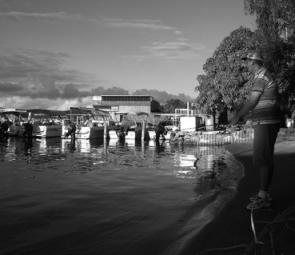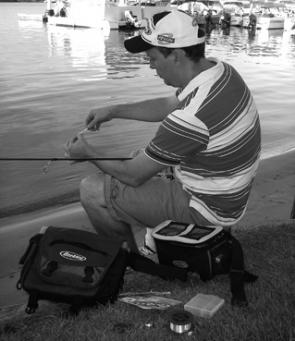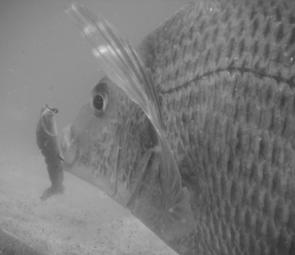Previously in our back to basics lure fishing column we have reviewed rods, reels, line, casting techniques and varieties of jigheads and soft plastics on the market.
I am often asked about the two options for fishing lures, those being on foot or from a floating platform. I thought we would investigate the opportunities for both over the next few columns. The reason for investigating these options is that each is associated with some advantages and disadvantages and as such, requires a slightly different approach. Selecting the right approach can mean the difference between success and going home fishless. Considering that many of us start fishing from the shore before we get into boats, I chose to start with the shore-based approach.
One of the best things to remember when fishing lures from the shore is that fish often feed in shallow and deep water that is tight up against the shore. Many anglers feel fishing from the shore disadvantages them. However, in my experience, I have found that as soon as you get rid of this thought pattern you will find you are on the way to catching more fish. Many friends of mine regularly fish from the shore and also regularly kick my butt when I am fishing from my boat. When I stop being lazy for a weekend and get out my walking shoes, I typically research better locations, find the best areas to access likely spots and ultimately fish better.
Fishing is a lot about knowing when and where to fish certain locations. A good place to begin approaching land based lure fishing is to start identifying likely fish holding structure that can be accessed on foot. As soon as you start to think about it you begin to identify heaps. In the salt environments you will find that bridges, rock walls, sand and weed flats, moored boats, river mouths, beaches and headlands (and the list goes on) are all structures that hold good concentrations of fish and can easily be fished by shore-bound anglers. The freshwater environments of impoundments and rivers provide structures such as dam walls and banks, weed beds, submerged snags and shallows that can usually be fished from miles of shoreline and riverside access.
At various stages of the seasons, day, night or tidal flow, fish will frequent specific types of structure. The trick then to fishing from land is to understand which accessible structures are going to fish well at any given time.
It would take many chapters to fully explain the manner in which to catch fish from a shore based. To keep it simple we will explore the thinking behind targeting a few common species and try to gain an understanding of the generic rules which will catch you more fish. The first part of the equation is to understand your prey. By trying to predict when in the day or year certain fish will frequent a type of structure to feed puts you in with a great chance of casting lures to feeding fish. To best illustrate my point I will provide some examples of approaches used to catch a few common species that, if applied, will work well on many others.
Flathead can be found in most waterways year round. During various stages of the year however they will congregate in greater numbers due to spawning influences. Flathead have very predictable habits and as such make for a good fishing option. As the tide builds up over shallow areas, flathead will hunt in these areas. My favourite time to chase these fish however is as the tide runs out. Flathead very predictably retreat to deeper water adjacent to the shallows to feed on food washing off these areas as the tide drops. Therefore walking the margins of sandy drop-offs and casting a lure as the tide drops is a great way to catch these fish.
Bream are also quite predictable in many waterways. During the start of the winter months, bream form large schools in the lower parts of estuarine systems allowing anglers to catch good numbers (and large specimens) of these fish. During the run-in tide, fish will cruise with a few mates in flooded shallows picking off whatever food they happen along. As the tide starts to retreat the fish also retreat beneath nearby structure in deeper water. If you target bream then fish the shallows during the run in tide and look for deeper, dark shady spots as the tide runs out.
The ‘Bash ‘Em Up Brigade’ includes some of the bigger beauties we see in our estuarine and inshore environments. These species include fish like mangrove jack, trevally, tailor, estuary cod and jew. Water temperature and bait movement has a lot to do with concentrations and activity levels of these fish. At certain periods of the year and day they make for viable options for the shore-based angler.
Structure that is located close to the shore will often provide a refuge for bait. The FAD effect this has ensures that bigger predators are never very far away. Our waterways are host to truckloads of boats and bridges that are in casting distance for shore based anglers. These structures at various stages of the year are home to heaps of quality fish. Places like the Gold Coast waterways are a haven for fish like jacks and trevally because of the plethora of man made structure. The time of day that shore based anglers target the bigger species has a lot to do with success rates. As the sun gets higher in the sky, many waterways become busy with regards to traffic. This activity will often make it harder to catch the larger more wary fish. Early in the day is the best time to target these fish. Surface or deeper water presentations pitched in close to structure will usually invoke some interest.
Some of our favourite freshwater options include species such as bass, saratoga, golden perch and Mary River cod. Many of these fish are predictable in that they will feed close to the margins of a waterway when the light conditions are low. Shore based structure including banks, weed beds, submerged timber, overhanging trees and dam walls make for good places to fish surface and shallow water presentations. As the sun rises higher in the sky, anglers typically produce more fish by working lures around deeper structure such as drop offs (banks, dam walls and deeper pools within a river) and submerged timber.
These examples of some of our favoured targeted species can hold true for many other species of fish. The idea is to research what your target species will do on a yearly and daily basis. The more you understand the habits of your prey, the more you will begin to catch them.
One of the attractive aspects of shore-based lure fishing is the ease and efficiency with which it can be accomplished. The only real pre-requisite for getting started in shore based lure fishing is that you have a good carry bag to store and transport your tackle. Other than your carry bag, all you need is a rod and reel, box of lures and jigheads and some good walking shoes. The art of shore-based fishing requires that you keep it simple. When I leave my boat at home, I take just what I need and spend more time thinking and watching the water for clues than rummaging around in my boat looking for a different piece of tackle or lure. The result is I ultimately fish better and catch more.
We will cover much more detail on technique in future editions of this column, however it is worthwhile giving you some basics to get you started from the shore right now.
Start your shore-based fishing with a 2” soft plastic grub. The Berkley 2” Tournament Grubs in pumpkinseed or bloodworm are two of the best lures I have in my box. These lures do a great job of imitating a prawn/shrimp or baitfish so will always attract attention. Rig the soft plastic on a jighead that will sink slowly to the bottom. A shore-based 2” soft plastic grub approach usually entails using a jighead around the 1/32oz to 1/16oz (or 0.5-1.5g) on a size 2 hook.
The retrieve to apply is known as the ‘hopped’ retrieve and will work well on most species.
1) Cast the lure tight against structure. For example, if you are fishing a bridge, cast the soft plastic against the concrete and allow it to fall into the water right against the pylon.
2) Allow the soft plastic to sink to the bottom. By watching the line, you will notice that it becomes slack as soon as the lure hits the bottom.
3) At this stage you want to give your rod tip two short jerks and lift the soft plastic up off the bottom (10 to 20cm per jig).
4) Having jigged the lure off the bottom, quickly wind up the slack line and then keeping the rod tip high, let the soft plastic flutter back to the bottom with the line kept TIGHT. If you feel a tap, or bite as the lure sinks then lift the rod tip. Many bites occur as the lure sinks so always watch the line and feel for bites as this happens.
Darren is a beginner to the lure fishing game and is a self-professed fishing no hoper and has become our back to basics guinea pig. The aim of using Darren is to show you how an absolute novice uses the information described in these columns.
The best part of showing Darren this fishing is that he suddenly woke with a wealth of opportunity on his doorstep. He doesn’t own a boat and didn’t place much stake in fishing the river near his home on foot. After an afternoon spent casting from the shore towards pontoons, boats and jetties, he caught several fish and suddenly had a wealth of ideas of similar shore based structure he could begin to fish. It is funny what a slightly different mindset will do to the way you approach your fishing!
It would be remiss of me not to mention the safety aspects of shore based lure fishing. The approach does bring with it various risks that are associated with accessing the natural environment. Anglers on foot should be mindful to wear shoes that are suitable for the terrain you wish to access. Falls are a real risk so take care (and a friend) if you are accessing high areas. The environment can take its toll on our health so make sure you wear sun protection and take your water. Finally, the Australian environment has its share of bities so wear suitable protection against snake and insect bites and be prepared for the instance that you might be bitten by something venomous.
Tournament anglers in boats often spend the majority of their time casting back into the shore because this is often where the fish are. It makes plenty of sense therefore, that shore-based anglers are in with an equally good chance of catching some great fish. The shallows hold plenty of food that fish will eagerly move into to feed on. These shallows are often accessible to shore bound anglers. By planning your fishing trip so that you are fishing the shallow shoreline structure when the fish are feeding there, you stand every chance of catching some great fish. When the fish are not in the shallows they will be feeding close to deeper structure. At this point an angler has to simply identify where the deeper structure is accessible from the shore and you have all bases covered.
So put on your thinking cap, followed by your joggers, get active and catch more fish!
Reads: 10474
There is plenty of fish holding structure close to the shore when you start to look for it.

A good carry bag for comfortably storing and transporting equipment is essential when lure fishing from the shore.

Early and late in the day make for good times for the shore-based angler to fish shallow structure.

Shallow feeding bream will readily grab a well-presented soft plastic such as this 2” Berkley Gulp Shrimp.




